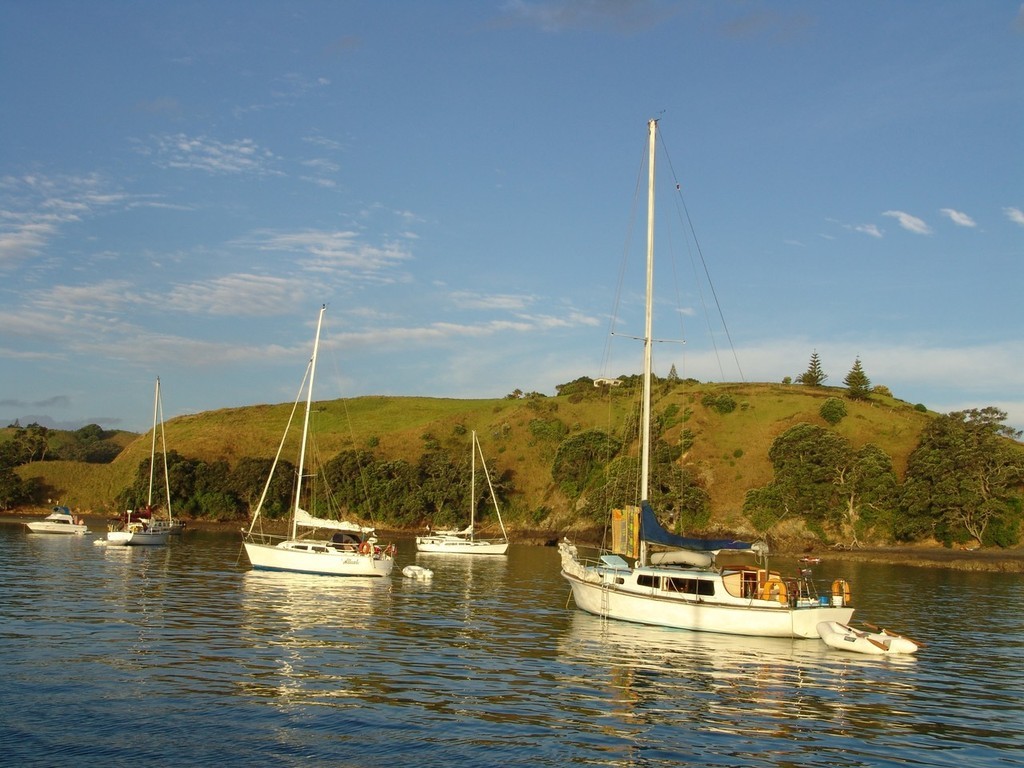Mooring mire stirs up a storm in the Hauraki Gulf
by Richard Gladwell, Sail-World on 27 May 2009

DSC03386.JPG Richard Gladwell
www.photosport.co.nz
An application to lay a mooring in picturesque Woody Bay on the western side of Rakino in Auckland's Hauraki Gulf, is generating a storm of protest and action from boaties of all types.
Submissions close on 12 June, and some interesting process in an earlier hearing has galvanised a response on the latest action. Four other such applications are understood to be in the pipeline for the island. A further 139 illegal moorings have been identified around Waiheke Island alone, which, if the Home Bay case were used as a precedent, could be rolled over, and made legal.
In an earlier decision, the Auckland Regional Council approved a previously illegal mooring site in Home Bay on the southern end of Rakino Island, about 12nm from Auckland. The application gave the holder rights over 3500sq metres of anchorage. It would seem that the decision did not meet several of the criteria set down as a 'policy response' used by the Environment Court in an Appeal over the placement of moorings (and other infrastructure) in Cowes Bay on eastern Waiheke Island.
The previous ARC decision granting a licence for a mooring in Home Bay was not taken to appeal by the regional association, Auckland Yachting and Powerboat Association. The reason the Home Bay decision was not Appealed by AYBA was that they apparently did not put in a submission against the original application and felt that as they were not a party to the original hearing, it was too hard to win on Appeal.
AYBA apparently checked with several clubs prior to the submission stage ,and few seemed to be interested, so a submission was not made.
Home Bay already has a wharf, one or two other moorings, and while it is a safe anchorage in some strong wind conditions, has no real beach and is not a popular day anchorage.
The Woody Bay application is quite different, in that the mooring licence is requested in a popular anchorage for boaties - both overnight and during daytime. The bay has an excellent sandy beach and is sheltered from a variety of wind directions.
The issues with moorings in areas are well known. Their gear on the seabed is unmarked for others wishing to anchor in the area, meaning that it is very easy to snag and anchor on the railway wheels or whatever weight is used - generally resulting in the loss of an anchor. The moorings are often laid in the best positions in the bay, and the owners demand full swing room for their boats which can often take an area of 2000-3500sq metres in a tight anchorage.
The practice is to designate certain areas as mooring areas, and to issue licences in those areas. For boaties, it is not a sound boating practice to anchor in a mooring area, due to the risk of snagging gear.
In the earlier Cowes Bay case, AYBA's Stephen Wagstaff was named as a party in the Hearing and attended for three days. The decision from Judge Newhook ran to 29 pages and covered the mooring issues and eight criteria as follows:
[44] Finally we turn to the aspect of moorings. In an Issues section the plan34 notes that individual moorings and groups of them can have an effect on the environment, particularly in terms of natural character, landscape and visual amenity values. As a result the plan attempts to concentrate the effect of moorings in defined locations in order to prevent their proliferation throughout the CMA. Thus mooring management areas are set down in the plan. One of the policy responses to the issue outlined is to regard new moorings outside the Mooring Management Area as generally inappropriate unless:
a. there is no Mooring Management Area in close proximity to the proposed mooring site that has available space; and
b. there are compelling reasons why a mooring outside a Mooring Management Area is necessary; and
c. it can be demonstrated that short term anchorage as opposed to a permanent mooring is not a practicable option; and
d. the mooring and any moored vessel will not adversely affect the navigation and safety of other vessels; and
e. the mooring and any moored vessel will not adversely affect other recreational use of the coastal marine area, including the short term anchorage of other recreational vessels; and
f. the mooring and any moored vessel will not adversely affect the operation of any existing activity or any activity that has been granted resource consent; and
g. there are no practicable land-based storage options; and
h. the mooring and any moored vessel will not restrict public access to and along the coastal marine area.
We recognise that this is a policy and not a rule or a set of assessment criteria. But the inescapable conclusion of the multiple conjunctive requirements which must be satisfied before moorings outside the Mooring Management Area can generally be regarded as acceptable, is that the AR.P:C has a policy thrust against such moorings.
The full Environment Court Decision can be read by http://www.sail-world.com/files/ENV2007AKL453_EnvCrt_Decision.pdf!clicking_here
Submissions close on the Woody Bay application on 12 June 2010
If you want to link to this article then please use this URL: www.sail-world.com/57205